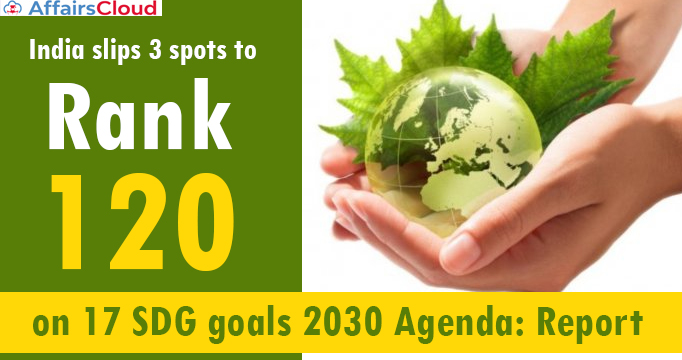 On March 1, 2022, Union Minister Bhupender Yadav, Ministry of Environment, Forest and Climate Change (MoEF&CC) released the 9th edition of Down To Earth’s annual ‘State of India’s Environment Report 2022’ at the 4-day long Anil Agarwal Dialogue (AAD) organised by Centre for Science and Environment (CSE) at CSE’s state-of-the-art residential environmental training facility, the Anil Agarwal Environment Training Institute (AAETI), in Nimli, Alwar district, Rajasthan.
On March 1, 2022, Union Minister Bhupender Yadav, Ministry of Environment, Forest and Climate Change (MoEF&CC) released the 9th edition of Down To Earth’s annual ‘State of India’s Environment Report 2022’ at the 4-day long Anil Agarwal Dialogue (AAD) organised by Centre for Science and Environment (CSE) at CSE’s state-of-the-art residential environmental training facility, the Anil Agarwal Environment Training Institute (AAETI), in Nimli, Alwar district, Rajasthan.
- As per the report, India has slipped three spots to 120 from 117 in 2021 on the 17 Sustainable Development Goals (SDGs) adopted as a part of the 2030 agenda by 192 United Nations member states in 2015. Click here to read about Agreement on SDGs
- India’s overall SDG score was 66 out of 100.
Key Points:
i.CSE is a not-for-profit public interest research and advocacy organisation.
ii.The report focuses on climate change, migration, health systems, forest & wildlife, energy, industry, habitat, pollution, waste, agriculture & rural development.
iii.AAD is an annual conclave of journalists. AAD 2022 saw the participation of over 60 journalists across India.
State/UT-wise preparedness to meet SDGs by 2030:
i.As per report, on the state-wise preparedness to meet the SDGs by the target year 2030, Kerala ranked 1st, followed by Tamil Nadu (TN) and Himachal Pradesh (HP) in the 2nd position.
- The 3rd position was shared by Goa, Karnataka, Andhra Pradesh and Uttarakhand.
ii.Jharkhand and Bihar are the least prepared to meet the SDGs by the target year 2030.
iii.Among the Union Territories (UTs), Chandigarh was ranked 1st, followed by Delhi, Lakshadweep and Puducherry in the 2nd place and the Andaman and Nicobar Islands on the 3rd.
Key Highlights from Report:
i.With the latest rankings, India is now behind all south Asian nations except Pakistan, which stands at 129.
- The south Asian countries ahead of India are Bhutan ranked 75, Sri Lanka (87), Nepal (96) and Bangladesh (109).
ii.India also performed poorly in dealing with quality education and life on land aspects
iii.India lacked on the fronts of ending hunger and achieving food security, achieving gender equality and building resilient infrastructure, promoting inclusive and sustainable industrialisation and fostering innovation.
iv.The key reason behind a drop in India’s ranking major challenges in 11 SDGs including zero hunger, good health and wellbeing, gender equality and sustainable cities and communities.
It should be noted that by 2030, India plans to have 500 GW (Giga Watt) from renewable energy, along with electrification of Railways which will reduce 80 billion tonnes of emissions. LED bulbs will also be employed at a large scale, which can reduce 40 billion tonnes of emissions.
Recent Related News:
On 6th December NITI (National Institute for Transforming India) Aayog and CSE released a report titled ‘Waste-wise Cities: Best practices in municipal solid waste management’, a comprehensive knowledge on India’s solid waste management.
About Centre for Science and Environment (CSE):
Founder– Anil Agarwal
Director General– Sunita Narain
Headquarter– New Delhi, Delhi




